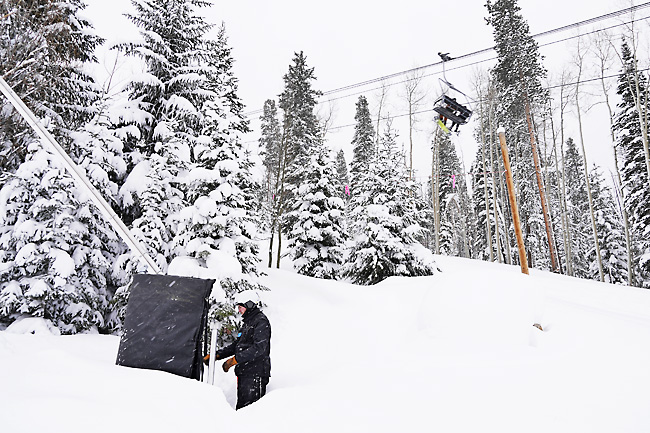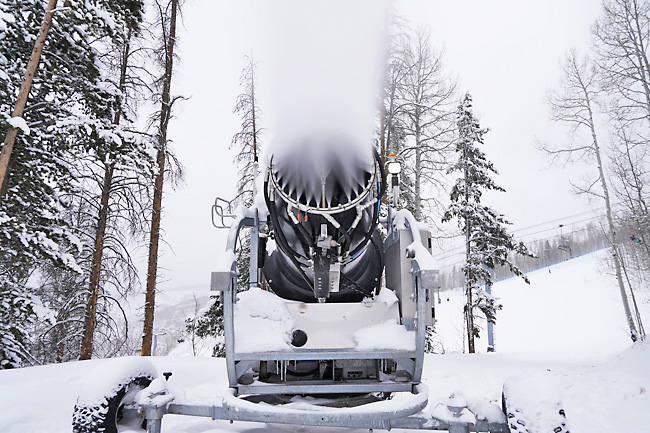Thomas Peipert
DENVER (AP) – The sight can be jarring during extreme drought: snowmaking guns lined up on a mountainside, blasting precious crystal flakes on a ski run while the rest of the land goes thirsty.
Snowpack in the United States (US) West has decreased by about 20 per cent in the last century, making man-made snow more vital each year to opening ski resorts and fuelling ski town economies as they head into an uncertain future.
As the effects of drought and climate change increasingly hit home, the ski industry has invested millions of dollars in more efficient snowmaking systems amid questions about whether the practice is a wise use of energy and water.
“There are impacts. They’re regrettable. We’d rather not have to make snow,” said Senior Vice President of sustainability at Aspen Skiing Company in Colorado Auden Schendler. “But our regional economy and the economies of all ski towns depend on your ski resort operating. And so this is a necessary evil.”
Snowmaking has been around since at least the 1950s, but the practice became widespread in the West after a drought in the late 1970s. According to the Colorado-based National Ski Areas Association, about 87 per cent of the 337 US alpine resorts the trade group represents have snowmaking capabilities.
Many resorts draw water from nearby streams or reservoirs and typically use compressed air and electricity to blow snow into piles on the slopes when it’s cold. Those piles are then spread into a base layer that allows resorts to open in the early winter and to stay open through the spring.


An analysis of most of the ski resorts in Colorado found snowmaking diverts about 1.5 billion gallons of water per year in the state, said state engineer and director of the Colorado Division of Water Resources Kevin Rein. That’s enough to fill about 2,200 Olympic-sized swimming pools. It sounds like a lot, but Rein said snowmaking accounts for less than one-tenth of one per cent of the water that is diverted in the state, with agriculture drawing about 85 per cent. Moreover, about 80 per cent of the water used in snowmaking returns to the watershed when the snow melts in the spring.
Snowmaking is recognised by the courts as a “beneficial use” in Colorado, said Rein, whose agency regulates the process. “It’s part of our tourism, it’s part of what we do in Colorado.”
But professor and head of the Department of Watershed Sciences at Utah State University Patrick Belmont said it’s important to note that a lot of energy is used during snowmaking, and a lot of water is lost through evaporation and sublimation.
“It’s not insignificant, especially in a place where we don’t have a whole lot of water to begin with. Every drop of water matters,” he said.
Belmont, an avid skier who recently published a wide-ranging study on snowmaking and climate change, also is concerned that man-made snow, which is denser and melts later than the real thing, can affect stream flows.
“There are a lot of fish that take their cues for things like when to spawn or when to do different things in their life based on how the flows are going up or down. So we’re changing those types of natural cues for some of those organisms,” he said.
Ski resorts have made huge strides in becoming more efficient and environmentally friendly, said Schendler, of the Aspen Skiing Company. But he also recalled a time when they often didn’t pay much attention to weather forecasts, only to see the fruits of their labour melt in the warm afternoon sun.
“One way the industry has gotten smarter is they said, ‘Look, we’re not going to make snow if it’s not cold and if there’s not a forecast for it to stay cold,” he said. “That sounds dumb and analogue, but this industry is historically very analogue.”
Many resorts also have invested heavily in recent years to upgrade their snowmaking operations. Some have dug storage ponds to collect water in the spring when it’s abundant, while a few are eying the use of reclaimed wastewater.
Colorado-based Vail Resorts, which owns 37 ski resorts in the US, Canada and Australia, announced during an earnings call in December a USD3.6 million investment into its sustainability efforts this year, including making its snowmaking operations more energy efficient.
Over the past few years, the company has upgraded more than 400 snow guns across its resorts to blast more snow with less energy in less time. Meanwhile, Breckenridge, which is owned by Vail Resorts and is one of the country’s largest and most popular ski areas, is getting 110 efficient snow guns.
“If I can make all the snow we need in a third the time, that’s a huge energy savings. It’s a huge labour savings,” said snowmaking manager at Colorado’s Vail Mountain Resort Kate Schifani.






